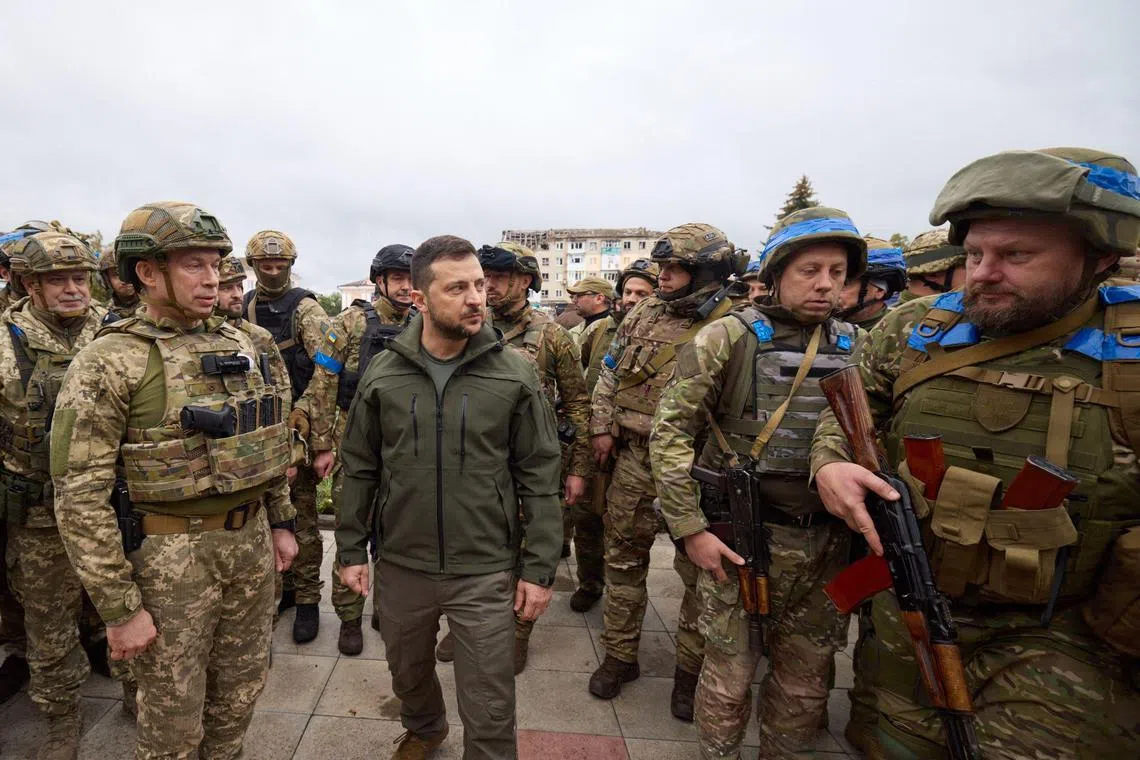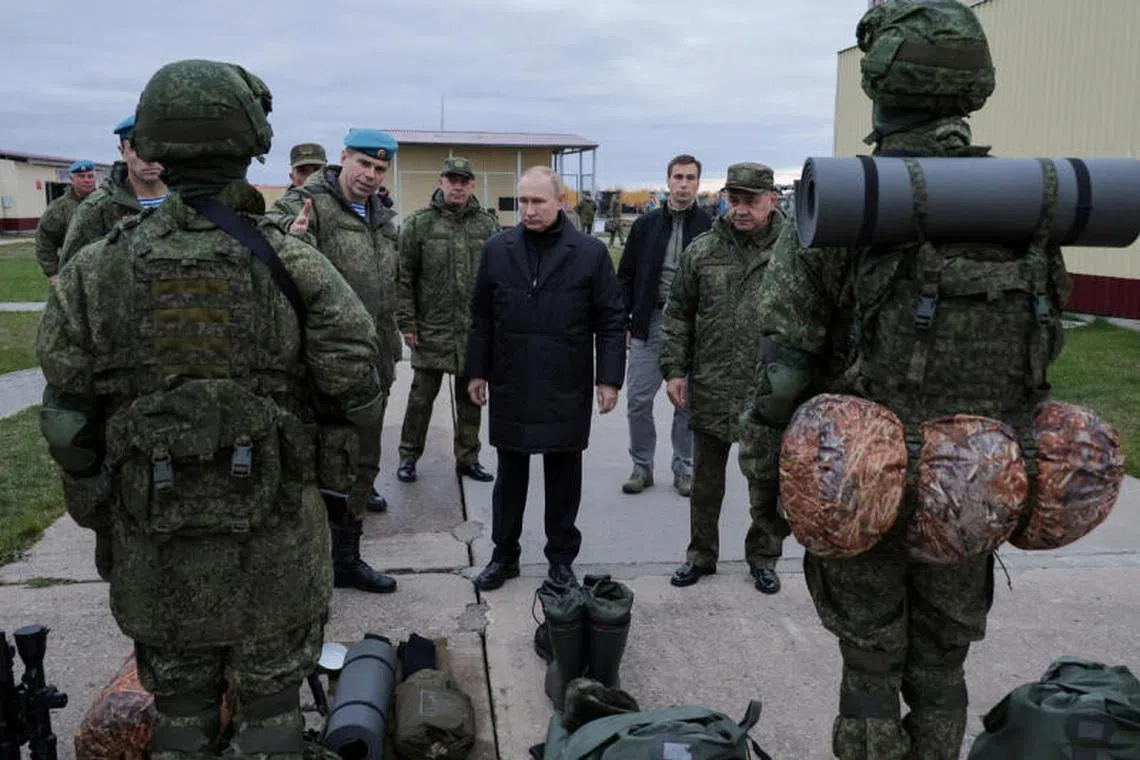Lauding their soldiers on Ukraine war’s 300th day, Putin and Zelensky signal long fight ahead
Sign up now: Get ST's newsletters delivered to your inbox

Mr Volodymyr Zelensky talking with servicemen during his visit to the de-occupied city of Izyum, Kharkiv region on Sept 14, 2022.
PHOTO: AFP
Follow topic:
KYIV - It was a moment that captured the intractability of a war that began nearly 10 months ago, featuring two antagonists presenting very different versions of the conflict.
The presidents of Ukraine and Russia both handed out medals on Tuesday.
Mr Volodymyr Zelensky of Ukraine, wearing a plain army-green jacket, on Tuesday made perhaps his most dangerous trip to the front lines
At almost the same time, Mr Vladimir Putin of Russia summoned pro-war figures and propaganda leaders to an ornate hall in the Kremlin, where he honoured them for their commitment to the invasion of Ukraine.
It was a split-screen moment that captured the intractability of a war that began 300 days ago and offered a stark contrast in wartime leadership, with Mr Zelensky flashing fresh defiance and Mr Putin signalling no letup in his assault.
Mr Zelensky was expected to make another daring trip on Wednesday – this time to meet with President Joe Biden at the White House and address Congress in person, according to four people familiar with the planning. The plans were not final, and the risks involved – with the Ukrainian leader making his first known trip outside his country since Russia invaded – are high.
Mr Putin’s televised event on Tuesday, meanwhile, appeared aimed at showing his audience – both at home and abroad – that he was determined to continue the fight despite what US officials say are Russian casualties now exceeding 100,000 dead and wounded.
Mr Zelensky’s visit to Bakhmut, whether by design or otherwise, stole some of the attention from Mr Putin by showcasing the Ukrainian leader’s defiance and tolerance for personal risk in a city so devastated by repeated Russian assaults that it evokes images of the wastelands of World War I.
Ukraine’s success at retaining control of the city in the eastern Donbas region has lent it a symbolism that outstrips its military significance. “Bakhmut Holds”, read bumper stickers, artwork and T-shirts that can be found across Ukraine.
“The east is holding out because Bakhmut is fighting,” Mr Zelensky said as he presented medals to Ukrainian soldiers and posed for photos. “This is the fortress of our morale. In fierce battles and at the cost of many lives, freedom is being defended here for all of us.”
Mr Putin, too, appeared to be steeling his citizens for a difficult fight ahead.
He honoured the Russia-installed leaders of four Ukrainian regions that Moscow illegally annexed in September,
“Thank you for wresting our people out of the bloody mouths of these man-eaters, despite the pain and the blood,” Ms Simonyan said, in an apparent reference to the Kremlin’s false claim that Ukraine has been perpetrating a genocide against Russian speakers. “And we will help you whack these man-eaters as much as you demand it from us.”
It was a reminder that Moscow’s powerful propaganda apparatus, like Mr Putin himself, has increasingly begun to acknowledge Russian struggles at the front, even if it still masks the extent of the losses. At the same time, Russian propaganda is presenting the war as existential – claiming that the true enemy is a Nato that seeks Russia’s destruction – and trying to brace Russians for further sacrifice.
Mr Putin, in a brief speech at the end of the ceremony, said these were “difficult, unusual times”, and praised Russian soldiers as “heroes.”
“When a country or even every person develops, moves forward, it always overcomes certain difficulties on this path,” he said. “But today, it’s indeed being accompanied by particular challenges.”
Mr Putin has been projecting an image in recent days of a leader more directly involved in the invasion.

Russian President Vladimir Putin listens at a training centre of the Western Military District for mobilised reservists, in Ryazan Region, Russia, on Oct 20, 2022.
PHOTO: REUTERS
Last Friday, he made an unannounced visit to a military command post coordinating the fight, the Kremlin said, without disclosing the location. And Monday, he made a rare visit to Belarus to strengthen military and economic bonds with the country’s authoritarian president, a close ally who has allowed the Russian military to use his territory as a staging ground for the war.
In Ukraine, concern has been intensifying that Russia may be planning a new offensive that could include a second attempt to seize Kyiv, the capital. Russia is planning the assault, Ukrainian officials say, even as it continues to attack Ukraine’s power plants and other important infrastructure in an effort to deprive the country of heat and light in the winter.
Energy officials say the attacks have left Kyiv with enough power for only about 20 per cent of the city’s 3.3 million residents, forcing utilities to institute longer and more unpredictable outages to keep the grid stable.
Some analysts have said it would be difficult for Russia to launch a larger offensive, since its forces have been worn down from 10 months of fighting and the recent battlefield successes of the Ukrainian military.
The Ukrainians, pointing to Moscow’s recent conscription of about 300,000 additional troops, fear that Russia intends to launch a ground offensive. And Russia has been signalling to the West that despite its heavy casualties, it is prepared for far more.
Mr Sergei Naryshkin, the chief of Russia’s foreign intelligence service, told the head of the CIA, Mr William Burns, last month that Russia would never give up, no matter how many troops it lost on the battlefield, The New York Times reported.
One Nato member has warned allies that Mr Putin is ready to accept the deaths or injuries of as many as 300,000 Russian troops, roughly three times his estimated losses so far. NYTIMES

